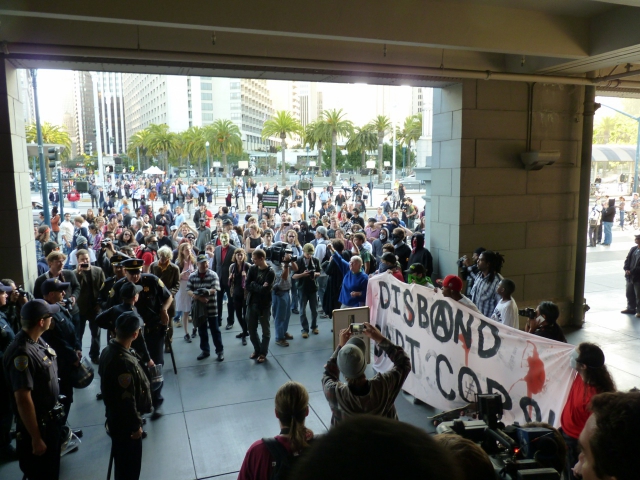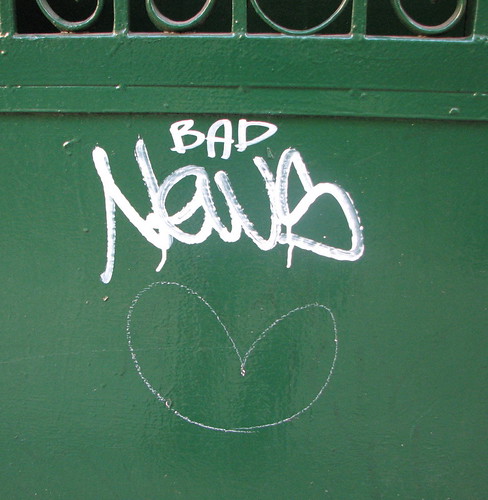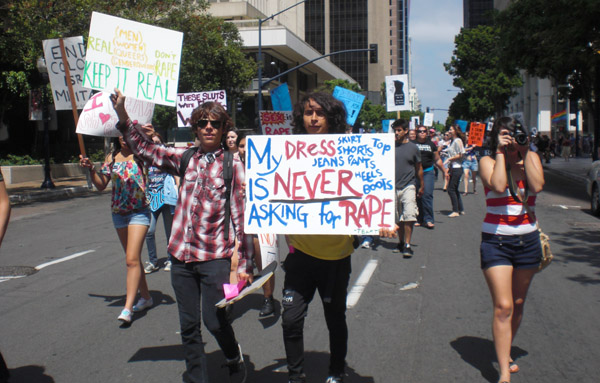Whenever they had a music break during one of their segments, however, the accompanying video would always be the same two pictures. One of them shows Bradley, a small, delicate blond youth, holding a sign calling for EQUALITY: @ The House @ The Classroom, @ the Battlefield, Everywhere, decorated with rainbow flags. I knew what that meant, even if Democracy Now! didn’t. The other picture shows Brad – as his friends call him – arm-in-arm and cheek-to-cheek with another guy. This guy, I now know, is Tyler Watkins, Manning’s boyfriend, who identifies as a drag queen.
A few months ago, I asked a friend who works with Courage to Resist, the organization formed to support GI Resisters, which since his arrest has been focusing mainly on Manning, whether Bradley was gay. He said he didn’t know. He looked a little surprised that I was asking, and I explained that I had seen the pictures on Democracy Now! and that if he is gay and out, we might be able to mobilize support for him – and by extension do anti-war organizing – in the queer community. He nodded and said it seemed like a good idea, but he didn’t have any idea how to get more info.
Not long after that encounter, I heard an announcement for a Free Bradley Manning contingent in the SF LGBT Freedom Day Parade. I joined it, and it was pretty good – most of the marchers seemed quite straight, but there were a few other queer leftists and a sign that said something about Bradley being a “gay hero.” The response from the crowd was excellent. We happened – or maybe it was less coincidental than that – to be lined up on the block with the ACLU, Amnesty International and the Lawyers Committee for Civil Rights, and nearly everyone in those contingents wore a Free Bradley Manning sticker too, so along with the huge banners courtesy of Courage to Resist and World Can’t Wait, we looked much bigger than we were. There were also contingents in a number of other cities, including New York, London, and Chicago.
I asked another friend who has been involved with the case if she knew why this apparently well-known information was only being spoken now, a year after Manning’s highly publicized arrest. She didn’t, but speculated that his supporters hadn’t wanted to “distract” from the whistleblowing. She mentioned that the right-wing had recently been using Manning’s sexuality to discredit him, and guessed that that was why the left had decided it was no longer unspeakable.
I don’t know why it never occurred to me to Google “Bradley Manning gay” before that. If I had I would have learned that the hacktivist blog Gawker had published an article on June 23, 2010, less than a month after Manning’s arrest, stating that, “It's been speculated that alleged Army leaker, PFC Bradley Manning, is transgendered. We've found evidence that strongly suggests Manning has some sort of LGBT identity, and that the man who snitched on him exploited this to win his trust.”
Two months after that, the New York Times published a piece that began: “He spent part of his childhood with his father in the arid plains of central Oklahoma, where classmates made fun of him for being a geek. He spent another part with his mother in a small, remote corner of southwest Wales, where classmates made fun of him for being gay.
In an article published on August 1, 2010, Manning’s mother told the UK Guardian, “‘He was different from other kids. He was interested in girls but he could never really get them to be interested in him. When he was 13, he told me he was gay.’
Around the same time, the British Daily Telegraph on July 30, 2010 ran a story containing the line, “Mr Manning, who is openly homosexual, …”
These stories revealed that Manning was active in trying to overturn Don’t Ask Don’t Tell – a very popular activity among straight servicepeople, I’m sure. The Facebook pages he linked on his profile were “LGBT America, Gay Marriage, Equality Maryland, Dan Savage, Human Rights Campaign.” The photo Democracy Now! keeps using, from the anti-DADT rally, came from his Facebook too.
Turns out the only people who DIDN’T know Bradley identified as gay were those of us who were getting our news from supposedly progressive media and the antiwar movement.
The question of Manning’s gender identity is more ambiguous. From the logs that have been published of his fateful chat with Adrian Lamo, the bisexual agent who turned him in to the government and then handed over the record of their chats to Wired magazine, it sounds like he was still figuring some of that out. According to the Gawker piece, “Lamo—who was once appointed to San Francisco's Lesbian Gay Bisexual Transgender, Queer and Questioning Youth Task Force … told the Times that ‘“It's [his queer identity] a personal matter for him, and I do not think it was one his family would want aired in the national media.”’
Did it occur to Lamo that Bradley’s family might not want their son held incommunicado at Quantico or Ft. Leavenworth?
Was shame over Lamo’s betrayal the reason queer organizations didn’t quickly rally behind Bradley, or was it, as LGBT historian Larry Goldsmith recently argued, because “Bradley Manning is not that butch patriotic homosexual, so central to the gays-in-the-military campaign, who Defends Democracy and Fights Terrorism with a virility indistinguishable from that of his straight buddies. He is not that pillar of social and economic stability, only incidentally homosexual, who returns home from the front to a respectable profession and a faithful spouse and children.”?
Or could it be that no one has asked them to get involved, because his sexuality and gender identity is a “distraction” that “shouldn’t be an issue”? I am not asserting that – I don’t know, but if my experience is at all typical, explicitly queer activism on Bradley’s behalf has not, until recently at least, been encouraged by the people mobilizing support for him.
So why should it be an issue? Should Ehren Watada’s Japanese ancestry have been an issue? Should Camilo Mejia’s Latino heritage, or the fact that Stephen Funk is a gay Filipino have been issues? No, except insofar as they helped to rally support for resisters, and to connect GI resistance to other liberation struggles. In our society, identity matters. And it’s clear that being gay and/or transgender is at least as important to Bradley Manning’s identity as the fact that his mother is Welsh.
Find out how you can Support Bradley Manning.
* Greenwald did finally mention Manning's "issues of sexual orientation and gender identity" in an article for Salon.com on July 4 of this year.
* Greenwald did finally mention Manning's "issues of sexual orientation and gender identity" in an article for Salon.com on July 4 of this year.










